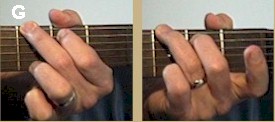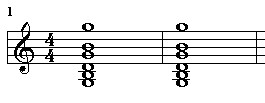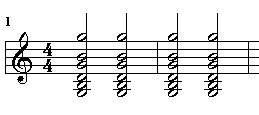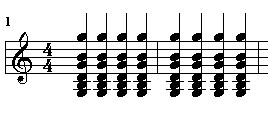Scroll through the lesson and click on notation/video/audio links to load the interactive players.
Please subscribe to get full access to all lessons for only $7.95/month PLUS 1 week free trial.

Riff Interactive lessons are
LESS expensive and
MORE interactive than alternatives!
More Info
|
|

Beginning Guitar V - Rhythm
Lesson 1
rhythm (r th th  m) m)
n.
1. Movement or variation characterized by the regular recurrence or
alternation of different quantities or conditions: the rhythm of the
tides.
2. The patterned, recurring alternations of contrasting
elements of sound or speech.
3. Music.
a.
The pattern of musical movement through time.
b. A specific
kind of such a pattern, formed by a series of notes differing in duration and
stress: a waltz rhythm.
c. A group of instruments
supplying the rhythm in a band. check
your tuning
Lyle: Welcome to this new series of lessons on
rhythm guitar for the beginning
guitarists. It's very important to be able to play
correct rhythm. You can be playing the simplest song but if your rhythm isn't
together, you'll sound off. I plan to help you feel comfortable with many of the
common rhythm patterns used in everyday guitar playing.
Lyle: Let's start by using the open G
chord:
G
chord

G chord
Lyle: Take this G chord and strum it once, with a
down stroke, on beat 1. Count to four and strum again on beat one. Listen to the
TAB file:
rhythm 1
whole note
rhythm
Lyle:
This is what's called a "whole" note rhythm pattern. You strum once on beat one
and let it ring for four beats. Nice and simple!
whole note
rhythm

Lyle: Now click the loop button for the tab file
and play along with me. You also need to count out loud and tap your foot to
each beat, just like in the video clip. This is your starting point for being able
to play smooth rhythms. You need to be comfortable strumming, counting out loud,
and tapping your foot, all at the same
time.
Lyle: Most of the time when I'm working with a
private student on this subject of rhythm and counting, they don't count out
loud when I ask them too. It can be hard to do at first. Counting out loud, tapping your foot, and
even rocking your body to the beat is all designed to get your body into the
groove, to be able to feel the beat and help you stay with it.
Lyle:
Let's try dividing the whole note pattern into what's called a half note
rhythm:
half note
rhythm

rhythm 2
half note
rhythm
Lyle:
Listen to the TAB so you hear the counting and the rhythm. Strum down on beats 1
and 3. Click the loop button for the TAB playback
so you can count, tap your foot, and strum along with me.
Lyle:
Now lets try strumming down on each of the 4 beats in the measure. This is
called a quarter note rhythm:
quarter note rhythm

quarter note rhythm
quarter note
rhythm
BigTX: Should
your foot be moving with the hand or independent?
Lyle: With the quarter note rhythm, you have
everything working together in sync. You have your strumming arm coming down on
each beat, your foot is coming down on each beat, and you're counting out loud
on each beat. Try looping the TAB and play along with me.
Lyle:
Now we'll divide the quarters in half to get eighth notes. Here's where it can
get tricky. Try this:
eighth note rhythm

eighth note rhythm
eighth note
rhythm
Lyle:
With the eighth note pattern you're moving your strumming arm and tapping your
foot together at the same speed as when you did the quarter notes, but now
you're catching the strings between each beat, thus making an up
stroke.
Lyle: In the TAB, the V is the down strum, ^ is
the up strum. This is also called the "down beat" and the "up
beat".
Lyle: Here's your assignment. Play all of the
rhythm patterns in order that we just worked on, like
this:
all 4
rhythms
Smitty: So,
what exactly is "back beat"?
all 4 rhythms
Lyle:
Back beat is a style of percussion in common time where a strong rhythmic accent
is sounded on the second and fourth beats of the bar, often from striking a
snare drum.
Lyle: Click the loop button for the last TAB and
play along to it.
Lyle: Thanks! Let's take a break here. Next
lesson we'll expand a little on this. Just keep counting and tapping and
strumming....
|
<< load notation from left
|
|
<< load audio from left
|
<< load audio from left
|